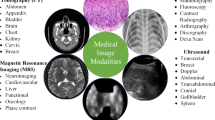Abstract
The choice of a convolutional neural network architecture and its parameters to extract optical character recognition is very difficult and tedious. The main objective of this work is to build a very robust and very fast architecture for the recognition of the handwritten characters of the Amazigh language written in Tifinagh character. This work has two optimized architectures, one to recognize RGB images and the other to recognize binary images. Very promising results are obtained compared to other existing systems in terms of precision, recall, F-measure and execution time.






Similar content being viewed by others
References
Niharmine, L., Outtaj, B., & Azouaoui, A. (2005). Recognition of handwritten Tifinagh characters using gradient direction features. Journal of Theoretical and Applied Information Technology, 95, 9.
Oujaoura, M., Minaoui, B., Fakir, M., El Ayachi, R., & Bencharef, O. (2014). Recognition of Isolated Printed Tifinagh characters. International Journal of Computers and Applications, 85, 1–13. https://doi.org/10.5120/14802-3005
Wahi, A., Sundaramurthy, S., & Ponnusamy, P. (2014). A comparative study for handwritten tamil character recognition using wavelet transform and Zernike moments. International Journal of Open Information Technologies, 2, 30–35.
Priyadarshni, S. J. S. (2016). Improvement of artificial neural network based character recognition system, using SciLab. Optik, 127, 10510–10518. https://doi.org/10.1016/j.ijleo.2016.05.106
Amara, M., Zidi, K., Zidi, S., & Ghedira, K. (2014). Arabic character recognition based M-SVM: Review. In A. E. Hassanien, M. F. Tolba, & A. A. Taher (Eds.), Advanced machine learning technologies and applications. (pp. 18–25). Cham: Springer. https://doi.org/10.1007/978-3-319-13461-1_3
Ouadid, Y., Elbalaoui, A., Boutaounte, M., Fakir, M., & Minaoui, B. (2019). Handwritten tifinagh character recognition using simple geometric shapes and graphs. Indonesian Journal of Electrical Engineering and Computer Science, 13, 598. https://doi.org/10.11591/ijeecs.v13.i2.pp598-605
Sadouk, L., Gadi, T., & Essoufi, E. H. (2017). Handwritten tifinagh character recognition using deep learning architectures. In Proceedings of the 1st international conference on Internet of Things and machine learning-IML ’17 (pp. 1–11). Liverpool: ACM Press. https://doi.org/10.1145/3109761.3109788.
Aharrane, N., Moutaouakil, K. E., & Satori, K. (2015). Recognition of handwritten Amazigh characters based on zoning methods and MLP. WSEAS Transactions on Computers, 14, 9.
Niharmine, L., Outtaj, B., & Azouaoui, A. (2018). Tifinagh handwritten character recognition using genetic algorithms. In 2018 international conference on advanced communication technologies and networking (CommNet) (pp. 1–6). Marrakech: IEEE. https://doi.org/10.1109/COMMNET.2018.8360267.
Benaddy, M., El Meslouhi, O., Es-saady, Y., & Kardouchi, M. (2019). Handwritten Tifinagh characters recognition using deep convolutional neural networks. Sensing and Imaging., 20, 9. https://doi.org/10.1007/s11220-019-0231-5
Es-Saady, Y., Amrouch, M., Rachidi, A., Yassa, M. E., & Mammass, D. (2014). Handwritten Tifinagh character recognition using baselines detection features. International Journal of Scientific and Engineering Research, 5, 7.
Lecun, Y., Bottou, L., Bengio, Y., & Haffner, P. (1998). Gradient-based learning applied to document recognition. Proceedings of the IEEE, 86, 2278–2324. https://doi.org/10.1109/5.726791
Ioffe, S., & Szegedy, C. (2015). Batch normalization: Accelerating deep network training by reducing internal covariate shift. arXiv:1502.03167.
Es Saady, Y., Rachidi, A., El Yassa, M., & Mammass, D. (2011). AMHCD: A database for amazigh handwritten character recognition research. International Journal of Computers and Applications, 27, 44–48. https://doi.org/10.5120/3286-4475
Wu, J., Chen, X.-Y., Zhang, H., Xiong, L.-D., Lei, H., & Deng, S.-H. (2019). Hyperparameter Optimization for Machine Learning Models Based on Bayesian Optimization. Journal of Electronic Science and Technology, 17, 26–40. https://doi.org/10.11989/JEST.1674-862X.80904120
Brochu, E., Cora, V. M., & de Freitas, N. (2010). A tutorial on Bayesian optimization of expensive cost functions, with application to active user modeling and hierarchical reinforcement learning. arXiv:1012.2599.
Bergstra, J., Yamins, D., & Cox, D. D. (2010). Making a Science of Model Search. Hyperparameter Optimization in Hundreds of Dimensions for Vision Architectures., 9, 62.
Author information
Authors and Affiliations
Corresponding author
Additional information
Publisher's Note
Springer Nature remains neutral with regard to jurisdictional claims in published maps and institutional affiliations.
Rights and permissions
About this article
Cite this article
Biniz, M., El Ayachi, R. Recognition of Tifinagh Characters Using Optimized Convolutional Neural Network. Sens Imaging 22, 28 (2021). https://doi.org/10.1007/s11220-021-00347-1
Received:
Revised:
Accepted:
Published:
DOI: https://doi.org/10.1007/s11220-021-00347-1




